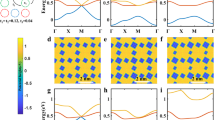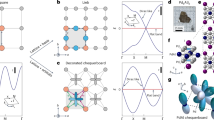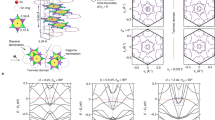Abstract
Geometry, whether on the atomic or nanoscale, is a key factor for the electronic band structure of materials. Some specific geometries give rise to novel and potentially useful electronic bands. For example, a honeycomb lattice leads to Dirac-type bands where the charge carriers behave as massless particles1. Theoretical predictions are triggering the exploration of novel two-dimensional (2D) geometries2,3,4,5,6,7,8,9,10, such as graphynes and the kagomé and Lieb lattices. The Lieb lattice is the 2D analogue of the 3D lattice exhibited by perovskites2; it is a square-depleted lattice, which is characterized by a band structure featuring Dirac cones intersected by a flat band. Whereas photonic and cold-atom Lieb lattices have been demonstrated11,12,13,14,15,16,17, an electronic equivalent in 2D is difficult to realize in an existing material. Here, we report an electronic Lieb lattice formed by the surface state electrons of Cu(111) confined by an array of carbon monoxide molecules positioned with a scanning tunnelling microscope. Using scanning tunnelling microscopy, spectroscopy and wavefunction mapping, we confirm the predicted characteristic electronic structure of the Lieb lattice. The experimental findings are corroborated by muffin-tin and tight-binding calculations. At higher energies, second-order electronic patterns are observed, which are equivalent to a super-Lieb lattice.
This is a preview of subscription content, access via your institution
Access options
Access Nature and 54 other Nature Portfolio journals
Get Nature+, our best-value online-access subscription
$32.99 / 30 days
cancel any time
Subscribe to this journal
Receive 12 print issues and online access
$259.00 per year
only $21.58 per issue
Buy this article
- Purchase on SpringerLink
- Instant access to full article PDF
Prices may be subject to local taxes which are calculated during checkout




Similar content being viewed by others
References
Castro Neto, A. H., Guinea, F., Peres, N. M. R., Novoselov, K. S. & Geim, A. K. The electronic properties of graphene. Rev. Mod. Phys. 81, 109–162 (2009).
Weeks, C. & Franz, M. Topological insulators on the Lieb and perovskite lattices. Phys. Rev. B 82, 085310 (2010).
Guo, H. M. & Franz, M. Topological insulator on the kagome lattice. Phys. Rev. B 80, 113102 (2009).
Apaja, V., Hyrkäs, M. & Manninen, M. Flat bands, Dirac cones, and atom dynamics in an optical lattice. Phys. Rev. A 82, 041402(R) (2010).
Goldman, N., Urban, D. F. & Bercioux, D. Topological phases for fermionic cold atoms on the Lieb lattice. Phys. Rev. A 83, 063601 (2011).
Beugeling, W., Everts, J. C. & Smith, C. M. Topological phase transitions driven by next-nearest-neighbor hopping in two-dimensional lattices. Phys. Rev. B 86, 195129 (2012).
Tadjine, A., Allan, G. & Delerue, C. From lattice Hamiltonians to tunable electron band structures by lithographic design. Phys. Rev. B 94, 075441 (2016).
Van Miert, G. & Smith, C. M. Dirac cones beyond the honeycomb lattice: a symmetry-based approach. Phys. Rev. B 93, 035401 (2016).
Li, S., Qiu, W.-X. & Gao, J.-H. Designing artificial two dimensional electron lattice on metal surface: a Kagome-like lattice as an example. Nanoscale 8, 12747–12754 (2016).
Di Liberto, M., Hemmerich, A. & Smith, C. M. Topological Varma superfluid in optical lattices. Phys. Rev. Lett. 117, 163001 (2016).
Shen, R., Shao, L. B., Wang, B. & Xing, D. Y. Single Dirac cone with a flat band touching on line-centered-square optical lattices. Phys. Rev. B 81, 041410(R) (2010).
Guzmán-Silva, D. et al. Experimental observation of bulk and edge transport in photonic Lieb lattices. New J. Phys. 16, 063061 (2014).
Mukherjee, S. et al. Observation of a localized flat-band state in a photonic Lieb lattice. Phys. Rev. Lett. 114, 245504 (2015).
Vicencio, R. A. et al. Observation of localized states in Lieb photonic lattices. Phys. Rev. Lett. 114, 245503 (2015).
Taie, S. et al. Coherent driving and freezing of bosonic matter wave in an optical Lieb lattice. Science Adv. 1, 1500854 (2015).
Xia, S. et al. Demonstration of flat-band image transmission in optically induced Lieb photonic lattices. Opt. Lett. 41, 1435–1438 (2016).
Diebel, F., Leykam, D., Kroesen, S., Denz, C. & Desyatnikov, A. S. Conical diffraction and composite Lieb bosons in photonic lattices. Phys. Rev. Lett. 116, 183902 (2016).
Lieb, E. H. Two theorems on the Hubbard model. Phys. Rev. Lett. 62, 1201–1204 (1989).
Costa, N. C., Mendes-Santos, T., Paiva, T., Dos Santos, R. R. & Scalettar, R. T. Ferromagnetism beyond Lieb’s theorem. Phys. Rev. B 94, 155107 (2016).
Zhao, A. & Shen, S.-Q. Quantum anomalous Hall effect in a flat band ferromagnet. Phys. Rev. B 85, 085209 (2012).
Jaworowski, B., Manolescu, A. & Potasz, P. Fractional Chern insulator phase at the transition between checkerboard and Lieb lattices. Phys. Rev. B 92, 245119 (2015).
Kopnin, N. B., Heikkilä, T. T. & Volovik, G. E. High-temperature surface superconductivity in topological flat-band systems. Phys. Rev. B 83, 220503(R) (2011).
Julku, A., Peotta, S., Vanhala, T. I., Kim, D. H. & Törmäi, P. Geometric origin of superfluidity in the Lieb-lattice flat band. Phys. Rev. Lett. 117, 045303 (2016).
Park, C.-H. & Louie, S. G. Making massless Dirac fermions from a patterned two-dimensional electron gas. Nano Lett. 9, 1793–1797 (2009).
Gomes, K. K., Mar, W., Ko, W., Guinea, F. & Manoharan, H. C. Designer Dirac fermions and topological phases in molecular graphene. Nature 483, 306–310 (2012).
Moon, C. R. et al. Quantum phase extraction in isospectral electronic nanostructures. Science 319, 782–787 (2008).
Moon, C., Mattos, L. S., Foster, B. K., Zeltzer, G. & Manoharan, H. C. Quantum holographic encoding in a two-dimensional electron gas. Nat. Nanotech. 4, 167–172 (2009).
Paavilainen, S., Ropo, M., Nieminen, J., Akola, J. & Räsänen, E. Coexisting honeycomb and Kagome characteristics in the electronic band structure of molecular graphene. Nano Lett. 16, 3519–3523 (2016).
Qiu, W.-X., Li, S., Gao, J.-H., Zhou, Y. & Zhang, F.-C. Designing an artificial Lieb lattice on a metal surface. Phys. Rev. B 94, 241409 (2016).
Nita, M., Ostahie, B. & Aldea, A. Spectral and transport properties of the two-dimensional Lieb lattice. Phys. Rev. B 87, 125428 (2013).
Urban, D. F., Bercioux, D. & Wimmer, M. Barrier transmission of Dirac-like pseudospin-one particles. Phys. Rev. B 84, 115136 (2011).
Meyer, G. et al. Controlled manipulation of atoms and small molecules with a low temperature scanning tunneling microscope. Single Mol. 1, 79–86 (2000).
Celotta, R. J. et al. Invited article: autonomous assembly of atomically perfect nanostructures using a scanning tunneling microscope. Rev. Sci. Instrum. 85, 121301 (2014).
Acknowledgements
Financial support from the Foundation for Fundamental Research on Matter (FOM, grants 16PR3245 and DDC13), which is part of the Netherlands Organisation for Scientific Research (NWO), as well as the European Research Council (‘FIRSTSTEP’,692691) is gratefully acknowledged. We thank J. van der Lit and N. van der Heijden for fruitful discussions.
Author information
Authors and Affiliations
Contributions
M.R.S., T.S.G., P.H.J. and I.S. planned the experiment, including the proposal of the design of the CO lattice. M.R.S. and T.S.G. performed the experiments and analysed the data. P.H.J. carried out the tight-binding calculations and G.C.P.v.M. performed the muffin-tin model calculations. S.J.M.Z. developed a program that partially automates the lattice assembly. All authors contributed to the discussions and the manuscript.
Corresponding author
Ethics declarations
Competing interests
The authors declare no competing financial interests.
Supplementary information
Supplementary information
Supplementary information (PDF 1930 kb)
Rights and permissions
About this article
Cite this article
Slot, M., Gardenier, T., Jacobse, P. et al. Experimental realization and characterization of an electronic Lieb lattice. Nature Phys 13, 672–676 (2017). https://doi.org/10.1038/nphys4105
Received:
Accepted:
Published:
Issue date:
DOI: https://doi.org/10.1038/nphys4105
This article is cited by
-
Structural constraint integration in a generative model for the discovery of quantum materials
Nature Materials (2025)
-
Topological magnetism in diluted artificial adatom lattices
npj Spintronics (2025)
-
Observation of compact localized states in synthetic Floquet-Lieb topological photonic lattices
Communications Physics (2025)
-
Recovering dark states by non-Hermiticity
AAPPS Bulletin (2025)
-
Emergence of flat bands and ferromagnetic fluctuations via orbital-selective electron correlations in Mn-based kagome metal
Nature Communications (2024)



